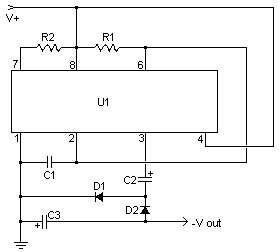
Battery voltage indication circuit

A battery voltage indication circuit that changes the status display. When the battery voltage is normal, an additional transistor drives an LED, which remains off. However, if the battery voltage falls below a critical threshold, the LED begins to flash, indicating a low battery condition.
This battery voltage indication circuit is designed to monitor the voltage level of a battery and provide a visual alert through an LED indicator. The circuit typically consists of a voltage divider network, a comparator, a transistor, and an LED.
The voltage divider is formed by two resistors connected in series across the battery terminals. This divider reduces the battery voltage to a level suitable for comparison. The output from the voltage divider is fed into a comparator, which is configured to compare the divided voltage against a predetermined reference voltage. This reference voltage is set to correspond to the critical battery voltage level.
When the battery voltage is above the critical threshold, the output of the comparator remains high, keeping the transistor in the off state. Consequently, the LED remains unlit, indicating that the battery voltage is normal. Conversely, when the battery voltage drops below the critical level, the comparator's output switches low, turning on the transistor. This action allows current to flow through the LED, which then begins to flash, signaling that the battery is low and requires attention.
The flashing behavior of the LED can be achieved by incorporating additional components, such as a capacitor and a resistor, to create a timing circuit that controls the on-off cycling of the LED. This feature enhances the visibility of the low battery condition, making it more noticeable to the user.
Overall, this circuit provides a simple yet effective method for monitoring battery voltage and ensuring timely awareness of low battery conditions through visual signaling. Battery voltage indication circuit Using this circuit can change the status display, if foot plus a further transistor drive LED, the battery voltage is normal. LED is not lit, and when the battery voltage falls below a critical value, LED begins to flash indicating that the circuit shown
This battery voltage indication circuit is designed to monitor the voltage level of a battery and provide a visual alert through an LED indicator. The circuit typically consists of a voltage divider network, a comparator, a transistor, and an LED.
The voltage divider is formed by two resistors connected in series across the battery terminals. This divider reduces the battery voltage to a level suitable for comparison. The output from the voltage divider is fed into a comparator, which is configured to compare the divided voltage against a predetermined reference voltage. This reference voltage is set to correspond to the critical battery voltage level.
When the battery voltage is above the critical threshold, the output of the comparator remains high, keeping the transistor in the off state. Consequently, the LED remains unlit, indicating that the battery voltage is normal. Conversely, when the battery voltage drops below the critical level, the comparator's output switches low, turning on the transistor. This action allows current to flow through the LED, which then begins to flash, signaling that the battery is low and requires attention.
The flashing behavior of the LED can be achieved by incorporating additional components, such as a capacitor and a resistor, to create a timing circuit that controls the on-off cycling of the LED. This feature enhances the visibility of the low battery condition, making it more noticeable to the user.
Overall, this circuit provides a simple yet effective method for monitoring battery voltage and ensuring timely awareness of low battery conditions through visual signaling. Battery voltage indication circuit Using this circuit can change the status display, if foot plus a further transistor drive LED, the battery voltage is normal. LED is not lit, and when the battery voltage falls below a critical value, LED begins to flash indicating that the circuit shown





